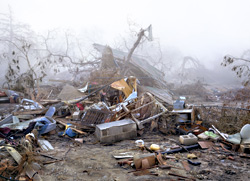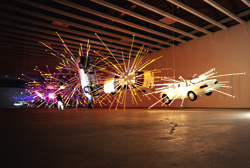Local photographer Chris Jordan has shifted his sharp, poetic focus from the wastelands of American consumerism—images of landfills of discarded cell phones, crushed cars, or computer chips—to the ruins of New Orleans in his latest book about last year’s hurricane disaster, In Katrina’s Wake: Portraits of Loss From an Unnatural Disaster. He is also one of four photographers taking part in the current group show of images from New Orleans at G. Gibson Gallery. As the Ballard-based artist explains to Seattle Weekly art critic Sue Peters, his new subject is not really such a departure from his previous themes.
Seattle Weekly:I’m familiar (and impressed) with your previous series of photos about American consumption, Intolerable Beauty: Portraits of American Mass Consumption. How did you move your focus from that subject to the devastation of Hurricane Katrina? Or is it a move? Are the two topics connected? If so, how?
Chris Jordan: My Katrina series is an extension of my earlier consumerism work, on a more personal level. There is evidence to suggest that Katrina was not an entirely natural event like an earthquake or tsunami. The 2005 hurricane season’s extraordinary severity can be linked to global warming, which America contributes to in disproportionate measure through our extravagant consumer and industrial practices. We consume a third of the world’s oil supply, despite being only 5 percent of the world’s population; hence, more than any other nation, we are responsible for global warming. Katrina serves as evidence that global warming is no longer an abstract academic issue about distant glaciers; it has now arrived on our doorstep and has destroyed the homes and belongings of 300,000 people in our own country. My newly released book, In Katrina’s Wake, contains an essay on this subject by author Bill McKibben.
Why did you go to New Orleans? Do you have any ties there?
I went down to New Orleans for several reasons. Primarily, it was because of the disconnect I was experiencing between the reports in the news about what was happening down there, and the statements being made by our federal government. Bush, in his typical way, appeared disengaged and in denial, reading his cheesy canned statements about how everything was fine while tens of thousands of our citizens were suffering in a way that would make the leaders of a third-world country cringe. It was clear to me that a monumental tragedy was happening on our Gulf Coast, and our government was doing the minimum it could get away with in terms of responding. And after a couple of months, even the media left the Gulf Coast behind and returned to more important stories about Tom Cruise and Katie Holmes. By sometime in late October, Katrina had all but dropped off the national radar screen, while people I know who live there were telling me horror stories about the conditions. I felt a draw to go down there and see for myself, and to maybe capture something that the media had missed.
What did you hope to capture in your photographs? Do you feel you have succeeded? (Is it possible to succeed?)
In terms of whether my Katrina series is successful, it definitely doesn’t portray the scale of the devastation; that can be experienced only by going there. Early on, I realized that the extent of the disaster was fundamentally unphotographable, like the Grand Canyon; it was just too huge and complex and overwhelming. So I focused on a specific aspect of the tragedy that held meaning for me: the personal details of people’s belongings strewn around the landscape. There were other aspects of the disaster that I could not photograph, such as the possibility that it was caused by global warming, and the implication that we were each individually responsible in some degree. To address this issue and some of the social issues around the aftermath, I contacted a couple of writers (Bill McKibben and Susan Zakin) and asked them to contribute essays. I also asked my wife, Victoria, (a poet) to contribute some poems, which she did. You will see that those contributions add layers of dimension to the book that make it more than just a photo monograph. My hope with this book was to reach a general audience rather than having it be a typical fine-art monograph that reaches only the art world. So there is no curatorial-type essay; the book is not intended to be about me or my art, but about the Katrina disaster. My photographs are intended to be illustrations that are readable by a general audience. If they also function as art, then that’s fine, but that was not the intention behind the project. So far, this work has been reaching a wide public audience, so maybe in that respect, you could say the project is having some success.
You focus your lens on elements of modern American life that (should) give one pause. Though your photos are often beautifully composed or executed, their subject matter is troubling and provocative. I’m assuming that this is a purposeful tension, yes?
The tension you noticed in my work between beauty and the not-so-beautiful is intentional, and it is something I am very interested in. I attempt to use beauty as a tool for seduction, to draw the viewer into territory they might otherwise be reluctant to enter. The underlying message in my work is not so pleasant, and to get it requires self-reflection and the overcoming of denial. The aesthetic aspects of my images—the high degree of fine detail, the repeating patterns and colors—are my way of inviting the viewer in close, to stay a while. Maybe during that time the deeper message might have a chance to seep in.
Have you ever been accused of being overly critical of America and ‘the American way of life’? How do/would you respond to that?
Interestingly, I get very little negative feedback for my criticism of the American way of life. Maybe it’s because we all know it is true, or maybe it is a reflection of the depth of our denial. When I exhibit my work and talk about our rampant consumerism, no one ever seems to think I am talking about them. So I get very little anger or negative response; people almost always take my side and speak zealously about consumer issues, even if they drive a huge SUV and work 2,000 hours a year to pay for their three homes and storage spaces filled with junk from Costco. This illustrates for me the complexity of the issue; talking to Americans about consumerism is like talking to someone with an alcohol problem, where it is just about impossible to break through the defensiveness. Our culture is in deep denial about what we are doing to our planet, to the people of other nations, and the people of the future, and about how our consumer lifestyle is sapping our own spirits. In my own life, I have lived in denial for many years about some major issues, so I know what denial looks like. It is incredibly sad to see it on such a huge scale, and growing ever broader under our current leadership.
It is always amazing for me to step outside our culture and visit a country like Brazil, where the priority is not money but joy. The people of Brazil are far less wealthy than we are, but they are visibly happier. You can see it in their faces and gestures, and hear it in their music, and see it in the way they spend their time. Coming back here can be depressing. America has lots its joy; we have become a nation consumed by greed, and our predominant national emotions are fear, hatred, and rage. It didn’t used to be this way; even in my own lifetime I remember when people worked less, took more vacations, spent more time with their families, and were satisfied with fewer cars, smaller houses, and less stuff. Just a few years ago, our stoves and countertops didn’t matter; now a $30,000 remodeled chef’s kitchen with granite countertops is standard in most middle-class homes even if no one in the house cooks. Today’s Honda Civic is far more luxurious than the best Mercedes of a couple of decades ago, yet everyone thinks they need more than a Honda Civic. We’re driving insane cars, buying insane amounts of stuff, and working insane hours to pay for it all. In the last few decades, the economy and the gaining of material wealth have subverted everything else that we value. We are trying to fill the spiritual void with iPods and plasma TV’s and so on, which at bottom is fundamentally empty and unfulfilling, so the cycle continues.
What are you hoping to achieve with your photos? Clearly your goals are not just artistic.
My instinct is to blame the Bush administration; right now for some strange reason we have the most unenlightened leaders in the history of our country. It is appalling how far backwards we have slid under this regime. But I recently read a quote that said that one aspect of democracy is that you get exactly the leaders you deserve. So maybe our leaders are just reflections of our culture. I fear that the real problem lies with us: you and me, our collective American Self, and the collective result of our individual greed. I am trying to fight against this wave, as part of a movement working on the fringe—artists, writers, musicians, thinkers, poets and the like—who are stepping back and trying to say something about the elephant that is standing in the room. Sometimes I feel hopeful that a new level of consciousness might reach a critical mass and spread to mainstream culture, but other times it just feels like I’m screaming into a hurricane.
I read that some of the proceeds from your latest book are going to a New Orleans–related charity. Can you tell me a few details about this?
One hundred percent of the proceeds from my book, as well as 100 percent of the proceeds from my fine-art print sales of the Katrina series this year, are all going to hurricane-relief charities. We have not yet chosen what charities to give the funds to, but it will be small local charities, not the big national bureaucratic ones like the Red Cross. My prints will be for sale through the G. Gibson Gallery, and Gail [Gibson] also has pledged a portion of her own proceeds from these sales to charities.







